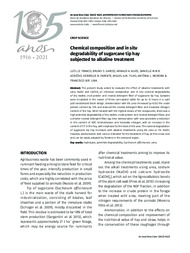Chemical composition and in situ degradability of sugarcane tip hay subjected to alkaline treatment.
Chemical composition and in situ degradability of sugarcane tip hay subjected to alkaline treatment.
Author(s): FRANCO, L. J. D.; GARCEZ, B. S.; ALVES, A. A.; AZEVEDO, D. M. M. R.; PARENTE, H. N.; M. FILHO, M. A.; MOREIRA, A. L.; LIMA, F. W. R.
Summary: The present study aimed to evaluate the effect of alkaline treatments with urea, NaOH and Ca(OH)2 on chemical composition and in situ ruminal degradability of dry matter, crud protein and neutral detergent fi ber of sugarcane tip hay. Samples were incubated in the rumen of three cannulated cattle for up to 72 hours in a split plot randomized block design. Ammoniation with 6% urea increased (p<0.05) the crude protein content by 13% and reduced the neutral detergent fi ber and insoluble nitrogen content of the hay. When treated with the highest doses of the compounds, there was a high potential degradability of dry matter, crude protein and neutral detergent fi ber, and a shorter neutral detergent fi ber lag time. Ammoniation with urea promotes a reduction in the content of NDF, hemicellulose and insoluble nitrogen, with an increase in the content of CP in the hay, with emphasis for the level of 6% urea. The ruminal degradation of sugarcane tip hay increases with alkaline treatments using 6% urea or 3% NaOH, however, ammoniation with urea is indicated for the treatment of hay, as this is low cost and can be easily adopted by farmers in the semiarid region.
Publication year: 2022
Types of publication: Journal article
Unit: Embrapa Mid-North
Keywords: Biodegradability, Degradabilidade, Hidrolise, Hydrolysis, Saccharum Officinarum, Urea, Uréia
Observation
Some of Embrapa's publications are published as ePub files. To read them, use or download one of the following free software options to your computer or mobile device. Android: Google Play Books; IOS: iBooks; Windows and Linux: Calibre.
Access other publications
Access the Agricultural Research Database (BDPA) to consult Embrapa's full library collection and records.
Visit Embrapa Bookstore to purchase books and other publications sold by Embrapa.

